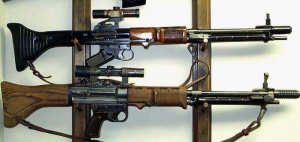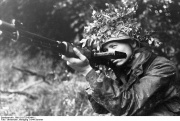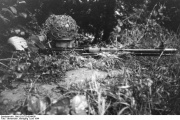FG 42
| |||||||||||||||||||||||||||||||||||||||||||||||||||||||||||||||||
The FG 42 (German: Fallschirmjägergewehr 42 or "paratroop rifle model 1942") was an automatic rifle produced in Nazi Germany during World War II. The weapon was developed specifically for the use with Fallschirmjäger airborne infantry in 1942 and used in very limited numbers until the end of the war. This unique firearm combined the characteristics and firepower of a light machine gun in a lightweight form no larger than the standard-issue Kar 98k bolt-action rifle. Considered one of the most advanced weapon designs of World War II,[1][2] the FG 42 would influence post-war small arms development (particularily in the M60 machine gun) and ultimately help shape the modern assault rifle concept.[3]
Contents |
[edit] Development
At the time of the Battle of Crete (Operation Mercury), German Fallschirmjäger were originally equipped with the same assortment of small arms as the Heer, carrying only pistols and hand grenades on them during airborne raids, with submachine guns, rifles and crew-served weapons stored separately in containers that were dropped from the wing of the exit craft. The German parachute harness, with a single strap attached to the body making the paratrooper land on his hands and knees in a forward roll, did not allow for heavier equipment such as rifles and machine guns to be safely carried during jumps. At Crete, long-range rifle fire from dug-in British defenders (largely New Zealanders from 5 Brigade's 22nd Battalion) inflicted heavy casualties upon the outgunned German paratroopers in the early stages of battle as they attempted to retrieve their support weapons from containers scattered all over the battlefield.[4] These early combat experiences demonstrated that standard weapons were not ideal for airborne operations.
In 1941, the German Air Force (Luftwaffe), requested a selective fire hand-held weapon for the paratroopers; Senior Staff Air Secretary Ossenbach at the GL/C Erprobungsstelle-6 (GL/C E-6—the Luftwaffe Weapons Development Branch at Tarnewitz near Lübeck) was approached informally to develop this special new weapon.[4] The Reich Air Ministry (Reichsluftfahrtministerium or RLM) sought to develop a universal shoulder-fired automatic rifle that would replace the bolt-action rifle, submachine gun, and light machine gun in the air assault role.[1] The proposed weapon would also simplify logistics and provide greater firepower to the individual paratrooper.
The RLM attempted to initiate a formal weapon development program through the Heereswaffenamt (the HWaA, or Army Ordnance Department)—responsible for German small arms development—but conflicting priorities and friction with the Army (the HWaA dismissed the undertaking as unrealistic and offered their G 41(W) semi-automatic rifle instead) led to an independent development by the Luftwaffe. Plans were laid out to form a central authority for the new program at the Luftwaffe testing station at Tarnewitz. The engineers on staff had acquired considerable expertise developing lightweight automatic weapons, having successfully converted the MG 15 aircraft machine gun to a ground configuration.[5] However, due to the dissapointing performance of the paratroopers during Operation Mercury, Hitler changed his mind about the tactical importance of airborne assaults and the plans were terminated.[5] Nevertheless, Luftwaffe Reichsmarschall Hermann Göring privately ordered the continuation of the project.[5]
The RLM went directly to German industry with its plans—the so-called LC-6 specification issued 14 December, 1941 mentioned amongst others that the weapon should not exceed 1,000 mm (39.4 in) in length, should not be significantly heavier than the Kar 98k rifle, should be able to fire single shots from a closed bolt, provide fully-automatic from an open bolt, feed from detachable 10 or 30-round magazines and be able to fire rifle grenades. Despite the introduction of the intermediate 7.92x33mm Kurz cartridge promoted by the Heer (developed for the promising MP 43 assault rifle), the Luftwaffe favoured the long-range potential of the standard 7.92x57mm Mauser rifle round and this caliber was one of the main design prerequisites.[1]
Six manufacturers were solicited for prototype designs: Gustloff-Werke, Mauser, Johannes Großfuß Metall- und Lackierwarenfabrik, C.G. Hänel, Rheinmetall-Borsig and Heinrich Krieghoff Waffenfabrik.[1][5] Several contracts were awarded but only a few prototypes are known to have been submitted. Mauser offered a version of the MG 81 (rejected due to excessive weight and its belt-fed operation)[6] while Krieghoff presented a rising-block prototype, which too was quickly dropped. A design credited to Rheinmetall-Borsig's Louis Stange of Sömmerda proved satisfactory and underwent military trials conducted by the GL/C E-6 test station at Tarnewitz in mid-1942.[1] This early prototype, known under the factory designation Gerät 450 ("device 450") or Ausführung "A" ("type A"), was intended to be a pure sheet metal design, using pressed steel in the construction of the receiver, buttstock and corrugated handguard. The proposed system of operation was modelled on that used in the World War I Lewis light machine gun, with a gas-operated turning bolt action geared to a spiral (clock-type) recoil spring.[7] The type "A" was never produced beyond model form, but the basic design layout was retained for further development.[8]
With the basic characteristics of the LC-6 accepted, a series of modifications followed. The revised Ausführung "B" replaced the sheet metal handguard with a resin-impregnated fibre type that provided protection against heat and a better grip when wet.[8]
These tests exposed several shortcomings, addressed by Stange in April 1942 with the LC-6/II prototype. The prototype was then submitted to a series of endurance tests led by the HWA and further modified to increase functional reliability and durability, resulting in the final LC-6/III prototype variant that would ultimately be accepted into production as the FG 42. Fifty rifles were fabricated by Rheinmetall-Borsig for evaluation purposes by the end of 1942.
A pre-series batch of 50 rifles was produced in early 1943 and 6 examples were sent to GL/C E-6 for additional testing. Almost identical to the LC-6/III, these guns differ from later models by using a smooth sheet metal buttstock and an experimental muzzle brake. The weapons experienced serious malfunctions: one rifle suffered a catastrophic failure after firing only 2,100 rounds, a soldier was injured when attempting to fire a rifle grenade and the pressed metal buttstock would deform after launching only several rifle grenades.
Several other improvements were made before being authorized for large-scale production. The original Rheinmetall design used chrome-nickel steel heavily in many essential components, a strategic alloy in short supply. When the Luftwaffe was finally given permission to produce 3,000 rifles for combat trials, the material specifications were changed to accomodate the use of manganese steel as a substitute.[1] The Heinrich Krieghoff company of Suhl (authors of the previous unsuccesful LC-6 tender) was contracted to manufacture the FG 42 in limited quantity as Rheinmetall did not have the capacity to bring the FG 42 into serial production. The weapon was first used by commandos during Operation Eiche in 1943—the bold rescue of Benito Mussolini by Fallschirmjäger led by Otto Skorzeny.
The weapon system would undergo continuous development, its expedited development, remedial changes to the original design and ever-changing Luftwaffe requirements would result in myriad of variants.[1] Post-war literature typically identifies three versions, however the Germans never recognized these as distinctive models; the "Model I", "Model II" and "Model III" were never officially referenced and period documents simply refer the weapon as the "FG 42", and the reference was always made to the latest production model.[9]
[edit] Design details

The FG 42 was a select-fire air-cooled weapon and one of the first to incorporate the the "straight-line" recoil configuration. The butt is of 16 gauge steel, hollow, and ridged to add to its structural strength. Trigger guard and pistol grip are light metal, and comfortable in either offhand or prone positions. The hand guard is of wood, 7 1/2 inches in length, with holes drilled in the top to facilitate cooling and ridges milled in the sides and bottom to prevent the hand from slipping. The bipod legs fold forward from a collar, to provide a housing for the bayonet, and clamp to the bayonet lug.
This layout, combined with the side magazine, placed both the center of gravity and the position of the shoulder stock nearly in line with the longitudinal axis of the bore, a feature increasing controllability during burst or automatic fire.[9] The operating system was derived from that used in the successful Lewis light machine gun with a gas piston-actuated turning bolt locking mechanism.[9] This system used pressurized exhaust gases from the bore and channeled them through a port in the barrel to a gas cylinder beneath the barrel which contained a long-stroke piston with an extension that interacted with a helical cam slot machined in the bolt carrier, driving it back and unlocking the bolt near the end of its travel. The weapon was locked into battery by two lugs on the bolt head which recessed into appropriate grooves machined into the receiver walls.
There is no quick-change feature incorporated in the barrel, which appears odd in a contemporary weapon. A combined flash hider and compensator perforated with 74, 1/8-inch holes drilled in the side of the body and with 8 1/8 inch holes drilled around the muzzle end at a 45 degree angle help to counteract the natural tendency of the muzzle to rise in firing — although this model, like the MGs 34 and 42, was designed with the barrel practically in line with the point of support against the shoulder to minimize this annoying habit of machine rifles stocked like an ordinary rifle.
The high sights of the weapon compensate for the absence of drop in the stock. This is very noticeable in the FG 42. The rear sight is a 1/16-inch aperture peep with a micrometer type adjustment, but no wind gauge. The bayonet is normally carried point-backward, clipped in the cylindrical stud. When it is to be fixed, the blade is removed and clipped into the stud, point forward.[10]
The FG 42 fired in semi-automatic mode from a closed bolt, accomplished by delaying the release of the firing pin (mounted on the bolt carrier and released by the front sear notch) until after the trigger had been pressed; the short lock time, and little movement in the action during firing translated into greater single-shot accuracy.[9] When operating in the automatic mode, the sear mechanism was designed to fire from an open bolt by simultaneously releasing both the bolt and bolt carrier. This had the advantage of preventing a phenomenon known as "cook off" where the heat of repeated rounds being fired caused a chambered round to overheat and prematurely ignite the powder or primer. With automatic fire selected, the bolt would remain open between bursts to provide maximum cooling.[9] The rotating fire selector switch was situated in the trigger group, above the pistol grip on the right side. The change lever also served as the safety,[9] disabling the sear mechanism when engaged.
The receiver was a sophisticated, machined alloy forging with the magazine housing placed on the left-hand side and the ejection port and operating handle on the right. The seemingly awkward placement of the magazine housing (horizontally to the side rather than directly beneath the receiver) allowed the bolt mechanism to extend into the buttstock assembly, effectively reducing the overall length of the weapon as the magazine well did not interfere with the location of the pistol grip. The pistol grip was integrated into the trigger group assembly, a separate housing containing the trigger mechanism and fire control components, and was formed from pressed sheet metal during fabrication from two separate halves and then welded together.[9]
The rifle fed laterally from either a 10 or 20-round detachable box magazine.
The FG42 was intended to fill a key niche in Nazi Germany's arsenal but was produced only in small numbers. It was somewhat well-received by paratroopers when tested, but it did have its drawbacks. The FG42 had a 20, or sometimes 10, round magazine that was mounted on the left side of the rifle. Though a side-mounted magazine was common in submachine guns, the larger magazine with heavier ammunition of a full-powered rifle tended to unbalance the weapon. In addition, muzzle rise with automatic fire was substantial and controllable bursts were difficult. This made full-automatic fire only marginally useful. The FG42 used a fairly sophisticated muzzle device that did help with recoil and muzzle flash, but made blast and noise much greater than on other similar weapons. The US M14 rifle had similar problems and attempts were made to upgrade that rifle the same way with an in-line stock and muzzle device.
Some features, such as the details of the gas-operated bolt selection process, were studied by US Army engineers after the war. These, along with some aspects of the MG42, are commonly reported to have been incorporated in the similarly troubled M60.
The American M41 Johnson LMG has many parallels with the contemporary FG42. Both had in-line stocks, fed from the left side, and both fired from the open bolt in automatic mode and closed bolt in semi-automatic mode. Despite these similarities, there is no evidence that either weapon had any effect on the design of the other. They were both seeking to solve similar problems.
[edit] Operation
Upon firing, the propelling gases are taken off through a .060-inch port, 6.5 inches from the commencement of the rifling, on the underside of the barrel, and impinge on a piston head .620 inches in diameter. The piston rod passes through a gas cylinder 1.25 inches in length, with four 1/4" exhaust ports at the rear end. After the head passes these ports where the gases are dissipated, the piston rod continues to move rearward through a cylindrical guide at the rear of the cylinder, under its own inertia.
The bolt mechanism is attached to the piston rod by a lug on the under side of the bolt. The lug slot is approximately 3/4" long and twists toward the left-hand side of the bolt, allowing the lug to cam and turn the bolt a quarter turn to the left, and disengage the locking lugs. After unlocking, the bolt moves straight to the rear, as in the Lewis gun (although the bolt is known as the Solothurn type) and the piston rod has 3/4" of free travel before the bolt is unlocked, permitting ample time for the gas pressure in the barrel to be released before the unlocking of the bolt takes place.
By the use of a change lever (which also acts as a safety), the gun may be operated either as a semiautomatic or with full automatic fire. The change lever brings into engagement one of two sears, depending on the type of fire selected. The unique (for the time) feature of the operation lies in the fact that the gun fires automatically from an open-bolt position and semiautomatically from the position of the closed bolt.
The firing pin is attached to the piston-rod lug and the bolt-body moves around it under spring pressure contained in the firing pin spring compressed behind the lug. After firing each shot, the recoil is partially absorbed by compressing a driving-rod spring which then drives the bolt forward again to carry a new cartridge from the magazine into the chamber. This completes the operating cycle. [10]
[edit] Deployment
After approximately 2,000 FG42s had been produced by Krieghoff, supplies of the manganese steel from which the receivers were forged were diverted to other needs; this meant a redesign was required to use stamped sheet metal in its place. Field reports were also requesting minor improvements, such as: relocating the bipod from the front of the handguard to the muzzle to reduce shot dispersion; changing the pistol grip angle to near vertical; enlarging the handguard and changing the stock from stamped steel to wood to minimize overheating.
[edit] See also
[edit] Resources

This article or section is missing resources, such as diagrams or manual links, and could use more input to fill in the missing bits. You (yes, you!) can help Gunsopedia provide more comprehensive information to our users by using your own knowledge to add to it.
[edit] References
- ↑ 1.0 1.1 1.2 1.3 1.4 1.5 1.6 Senich, Peter: The German Assault Rifle: 1935–1945, page 239. Paladin Press, 1987.
- ↑ Miller, David: Fighting Men of World War II: Axis Forces : Uniforms, Equipment and Weapons, page 104. Stackpole Books, 2007.
- ↑ Bishop, Chris: The Encyclopedia of Weapons of World War II, page 217. Sterling Publishing, 2002.
- ↑ 4.0 4.1 Dugelby, Thomas B.: Death from Above—The German FG42 Paratroop Rifle, page 3. Collector Grade Publications, 2007.
- ↑ 5.0 5.1 5.2 5.3 Dugelby, 4
- ↑ Dugelby, 5
- ↑ Dugelby, 8
- ↑ 8.0 8.1 Dugelby, 9
- ↑ 9.0 9.1 9.2 9.3 9.4 9.5 9.6 Senich, 240
- ↑ 10.0 10.1 "Tactical and Technical Trends, No. 38," U.S. War Department publication, November 18, 1943.
[edit] Bibliography
- Bishop, Peter (2002). The Encyclopedia of Weapons of World War II. New York, NY: Sterling Publishing. ISBN 1586637622.
- Dugelby, Thomas B.; R. Blake Stevens (1990, 2007). Death from Above—The German FG42 Paratroop Rifle. Cobourg, ON: Collector Grade Publications. ISBN 0-88935-429-4.
- Miller, David (2007). Fighting Men of World War II: Axis Forces : Uniforms, Equipment and Weapons. Mechanicsburg, PA: Stackpole Books. ISBN 978-0-8117-0277-5.
- Senich, Peter (1987). The German Assault Rifle: 1935-1945. Boulder, CO: Paladin Press. ISBN 0-87364-400-X.



